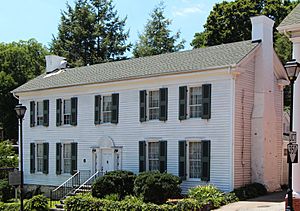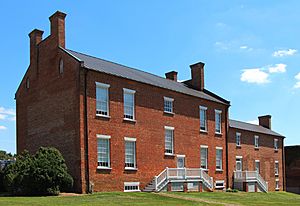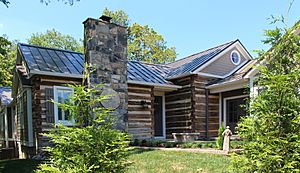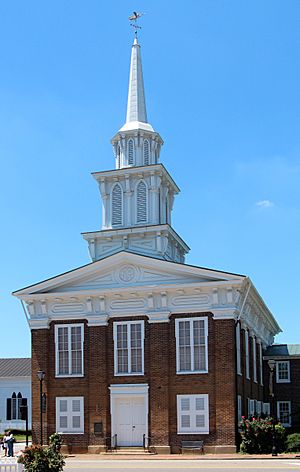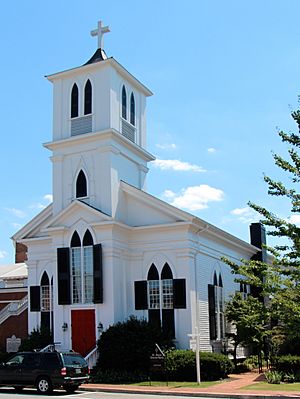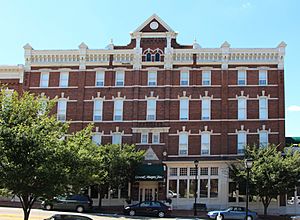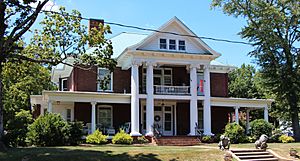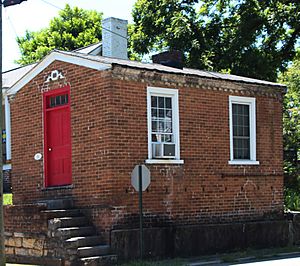Greeneville Historic District (Greeneville, Tennessee) facts for kids
Quick facts for kids |
|
|
Greeneville Historic District
|
|
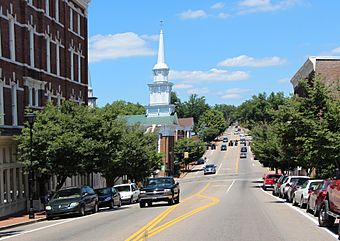
Main Street, Greeneville, Tennessee
|
|
| Lua error in Module:Location_map at line 420: attempt to index field 'wikibase' (a nil value). | |
| Location | Roughly bounded by Irish, Nelson, E. Church, College and McKee Sts., Greeneville, Tennessee |
|---|---|
| Area | 135 acres (55 ha) |
| Architect | Multiple |
| Architectural style | Greek Revival, Late Victorian, Federal |
| NRHP reference No. | 74001913 |
| Added to NRHP | May 3, 1974 |
Greeneville, the main town in Greene County, was started way back in 1783. It's one of the most important historic towns in East Tennessee. Even though many old buildings are gone, lots of important ones still stand today. These buildings are special because of their history or their cool old designs.
The Greeneville Historic District is a special area in town. It covers about 135 acres and has around 175 buildings. This district includes the area one block in every direction from Main Street, stretching from McKee Street to Nelson Street.
Greeneville was named after General Nathanael Greene, a hero from the American Revolutionary War. Early settlers, many of whom were Scotch-Irish, built the town around a natural spring. Because it was on important trade and travel routes, Greeneville became a busy and successful community before the Civil War. People built impressive homes and businesses, and many of these buildings are now part of the historic district.
Contents
Exploring Historic Buildings in Greeneville
Greeneville is home to many fascinating buildings. Each one tells a story about the town's past. Let's look at some of the most interesting ones.
Famous Homes and Important Places
The Andrew Johnson Home
This house at 217 South Main Street was bought by Andrew Johnson around 1851. He lived here until he passed away. Johnson was a very important person in American history. He served as a governor, a congressman, a senator, and even became the President of the United States!
The Susong House
Located at 202 South Main Street, this house was built in 1795. It started as a two-story log cabin built by Valentine Sevier. Later, it was covered with wooden boards. This makes it the oldest building still standing in Greeneville!
The Dickson-Williams Mansion
Built around 1820 at 106 North Irish Street, this mansion was probably the most impressive house in East Tennessee when it was new. During the Civil War, both Union and Confederate armies used it as a headquarters. Sadly, General Morgan, a Confederate general, spent his last night here. He was killed by Union soldiers in the mansion's gardens.
Valentine Sevier House
You can find this house at 214 North Main Street. It was built in 1822 by a nephew of John Sevier, who was Tennessee's very first governor. It's a great example of the Federal style.
Antrium Log Cabin
This log cabin at 307 North Main Street was built around 1800. It wasn't always in Greeneville! It was originally built in a rural part of Greene County and then moved to its current spot in 1965.
Historic Churches
Cumberland Presbyterian Church
This church at 201 North Main Street was built in the 1860s. The land for it was bought from Andrew Johnson himself! During the Civil War, this building was used as both a hospital for soldiers and a stable for horses. It was even shelled (attacked with cannons) on September 4, 1864.
First Presbyterian Church
Located at 110 North Main Street, this church was built in 1847. The congregation (the group of people who attend the church) is the oldest in Greeneville. It started in 1780 and had over 1,000 members before 1790!
Saint James Episcopal Church
This church at 105 North Church Street was built in 1850. It has a special gallery where enslaved people would sit. It also has an organ that is believed to be the oldest one in all of Tennessee!
Other Notable Buildings
Hotel Brumley
Found at 109 North Main Street, this hotel was built in 1884. It was first called the Grand Central. People said it was the best hotel "from Chattanooga to Roanoke" back then! Today, it's known as The General Morgan Inn.
W. H. Doughty House
This house at 309 North Main Street was built between 1906 and 1907. It shows off the Greek Revival style, which was popular for its grand, classical look.
Clawson-McDowell-Brown Home
This home at 204 South Main Street was built in 1810 and is another example of Federal style.
Lowry Snapp House
Built around the 1840s, this house is located at 216 South Irish Street.
Armitage-McKee Law Office
This old law office is at the corner of McKee and Irish Streets. It was built around 1860.
Images for kids



